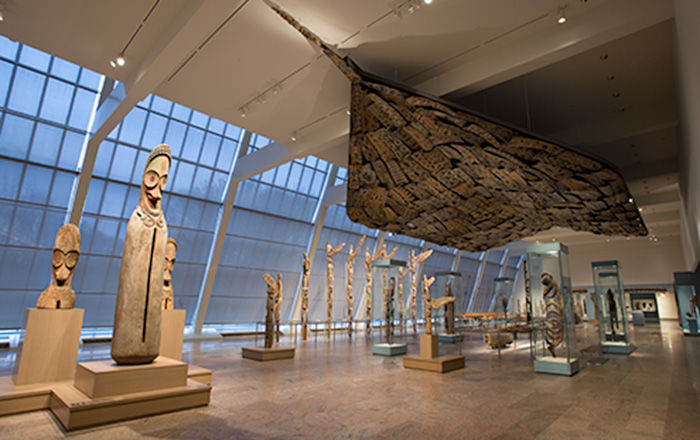Akua 'ba figure
Not on view
The name akua ‘ba (literally, Akua’s child) derives from an Akan legend about a woman named Akua who struggled with infertility. To address her condition, she consulted a priest who advised her to commission the carving of a small wooden child and care for it as she would a living baby, including nursing it and putting it to bed. Despite facing public ridicule with members of her community mockingly calling the figure “akua ‘ba,” her care and dedication to the figure led to a successful pregnancy and the birth of her daughter, which inspired other women to craft similar figurines. Along with conception, akua ‘maa (plural) may be prescribed to prevent complications during pregnancy and childbirth and to avert disease so that the mother and child remain healthy.
The style of this example relates to akua ‘maa carved among the Asante, the ruling confederacy of the Akan. Distinctive features include an elongated forehead on a round head; thin nose; sweeping, arched eyebrows; small, pursed lips; a ringed neck; and large eyes that are identified by narrow slits that slightly protrude from the surface. These features emphasize the feminine ideal for which physical and moral beauty were closely intertwined. For example, wisdom is emphasized through the elongated forehead, and wealth and nourishment depicted through the ringed neck of a well-fed individual. Women would give their akua ‘maa these characteristics in the hope that their daughter would inherit them. A unique part of this figurine’s design is the rectilinear chest that compartmentalizes the head and lower body as opposed to a seamless connection between the two.
This akua ‘ba has two small cross-shaped marks that were etched on both of its cheeks. The Asante generally do not practice facial cicatrization except for medicinal purposes. Examples of medicinal marks on akua ‘maa are horizontal lines which relate to cicatrization patterns applied for convulsions. The cross-shaped marks could indicate a treatment for a different condition, or may serve as general protection against physical and mental harm. Relatedly, this figure features an upside-down Y-shape mark on its upper back. This symbol was deployed to ward off witchcraft.
The back of this figurine’s head has an etched pattern of two horizontal U-shape marks that mirror each other across the central axis and are repeated in an additional row. Many akua ‘maa have one, two, or three rows of this design. The U-shape mark could represent the waxing and waning moon—interconnected forces often associated with regeneration. The crescent moon is a female symbol among the Asante because of its connection to the queen mother, who is understood as the daughter of the moon. She is a powerful figure in state affairs and often complementary to the chief. The moon is also seen as the female aspect of Nyame, the Supreme Creator. As a female symbol, it represents women’s beauty, tenderness, and gracefulness.
Ellie Luchini
Roswell L. Gilpatric MuSe Intern, 2025
This image cannot be enlarged, viewed at full screen, or downloaded.
This artwork is meant to be viewed from right to left. Scroll left to view more.

